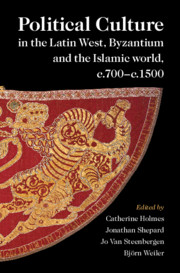 Political Culture in the Latin West, Byzantium and the Islamic World, c.700–c.1500
Political Culture in the Latin West, Byzantium and the Islamic World, c.700–c.1500 Book contents
- Political Culture in the Latin West, Byzantium and the Islamic World, c.700–c.1500
- Political Culture in the Latin West, Byzantium and the Islamic World, c.700–c.1500
- Copyright page
- Contents
- Figures and Maps
- Contributors
- Preface and Acknowledgements
- Abbreviations
- General Maps
- 1 Political Culture in Three Spheres
- 2 Reflections on Political Culture in Three Spheres
- Part I Sources
- Part II Historical Contexts
- Part III Norms, Values and Their Propagation
- 10 The Latin West
- 11 Byzantium
- 12 The Islamic World
- Part IV Practice and Organisation
- Part V Conclusions
- Appendix
- Glossary
- Index
11 - Byzantium
Imperial Order, Constantinopolitan Ceremonial and Pyramids of Power
from Part III - Norms, Values and Their Propagation
Published online by Cambridge University Press: 11 August 2021
- Political Culture in the Latin West, Byzantium and the Islamic World, c.700–c.1500
- Political Culture in the Latin West, Byzantium and the Islamic World, c.700–c.1500
- Copyright page
- Contents
- Figures and Maps
- Contributors
- Preface and Acknowledgements
- Abbreviations
- General Maps
- 1 Political Culture in Three Spheres
- 2 Reflections on Political Culture in Three Spheres
- Part I Sources
- Part II Historical Contexts
- Part III Norms, Values and Their Propagation
- 10 The Latin West
- 11 Byzantium
- 12 The Islamic World
- Part IV Practice and Organisation
- Part V Conclusions
- Appendix
- Glossary
- Index
Summary
This chapter is mainly concerned with the political ideology, norms and behaviour associated with the Byzantine monarchy. It focuses on how the ceremonial and hierarchies of power played out in Constantinople, assessing contemporary expectations of the role and conduct of the emperor. Such expectations were often revealed most clearly in time of instability, as contemporary accounts of coups indicate. The chapter outlines the ceremonial life of the court and discusses the sacred and secular topography of Constantinople as the stage for the continuous display of elite power. The visual and non-verbal qualities to Byzantine ceremonial culture are stressed, as is the centrality of law to imperial authority, political office and spatial organisation. The principal imperial hierarchies of power (military, civil and clerical) and the relationship of the emperor and patriarch are explored, with women and eunuchs seen as integral to the workings of official hierarchies. Alternative concepts of power began to emerge in the later period, when the empire’s territorial integrity was eroding, yet the long-term resilience of traditional ideology, ceremonies and hierarchies is noteworthy.
- Type
- Chapter
- Information
- Political Culture in the Latin West, Byzantium and the Islamic World, c.700–c.1500A Framework for Comparing Three Spheres, pp. 290 - 329Publisher: Cambridge University PressPrint publication year: 2021
